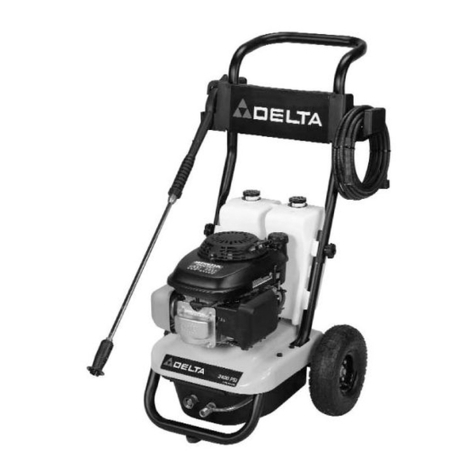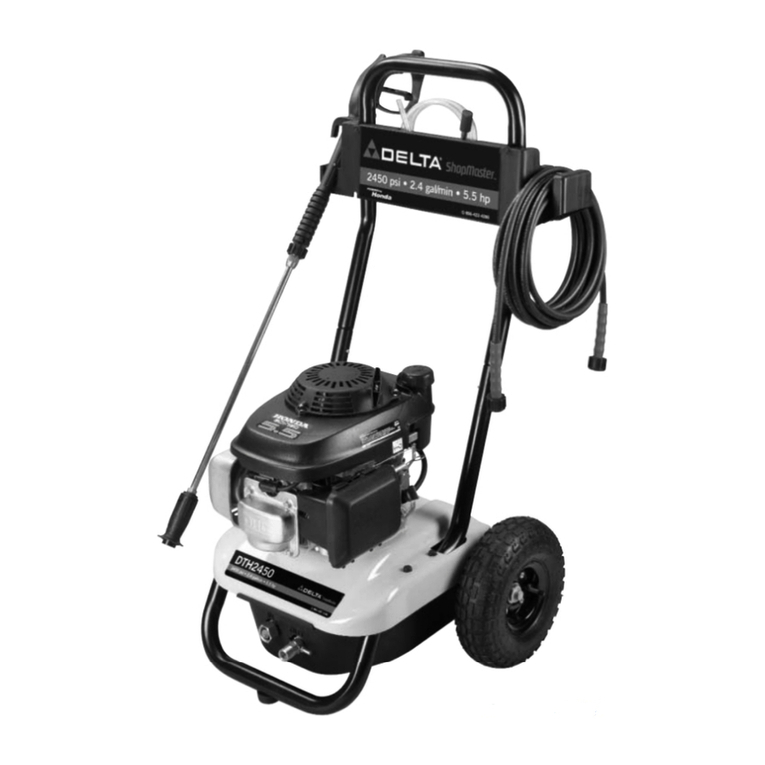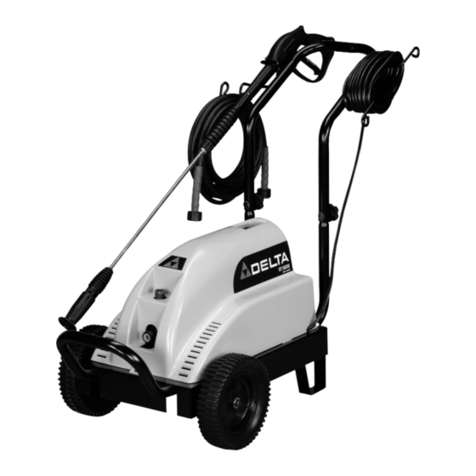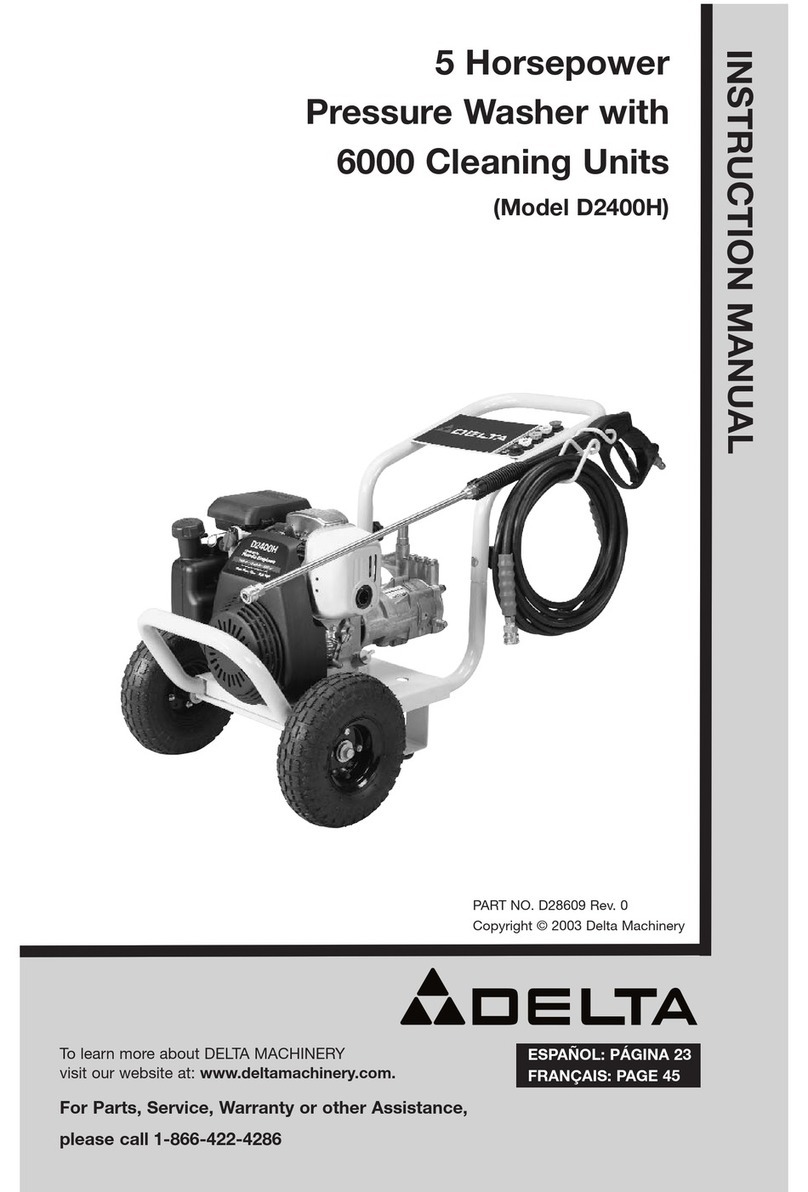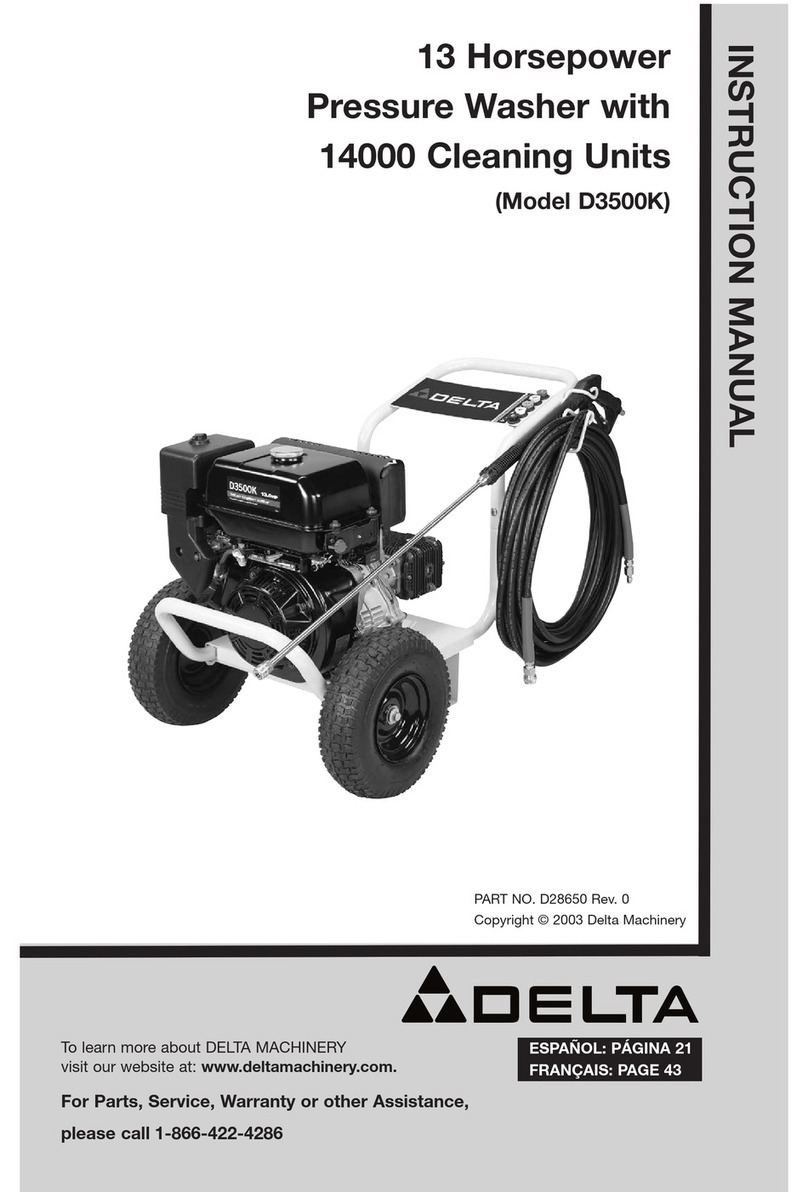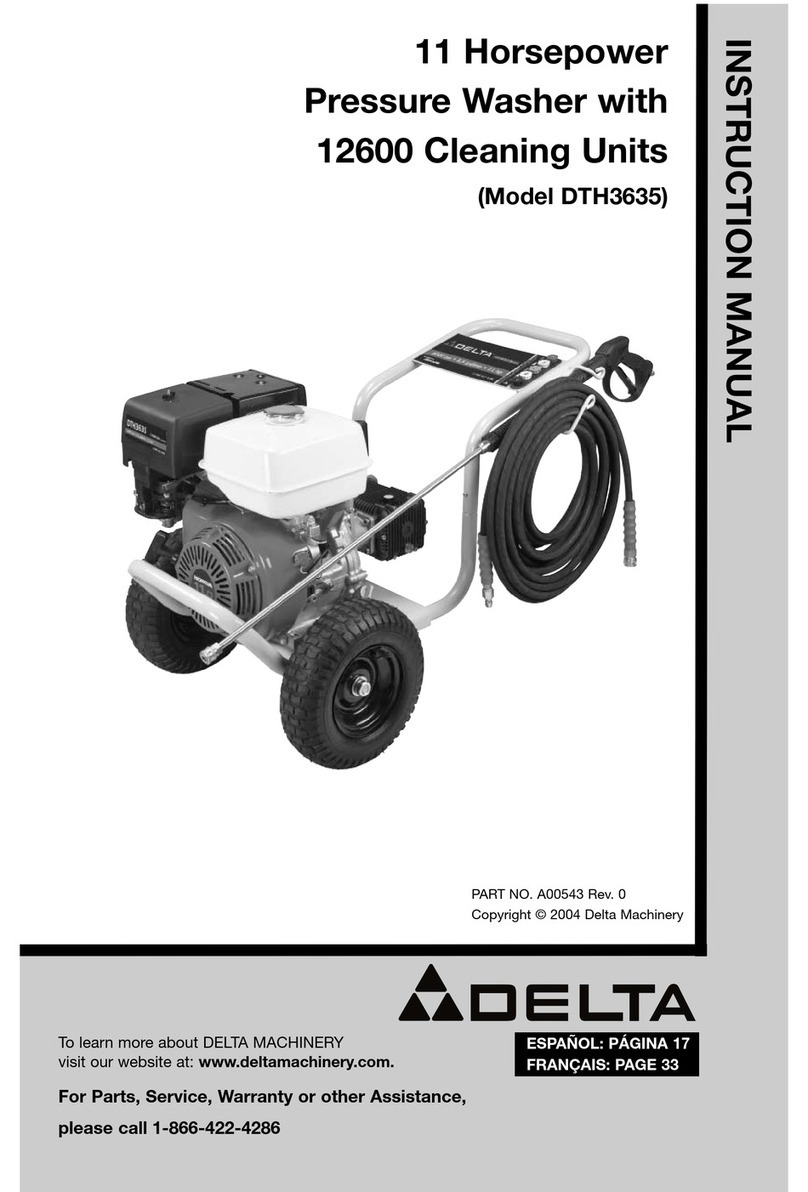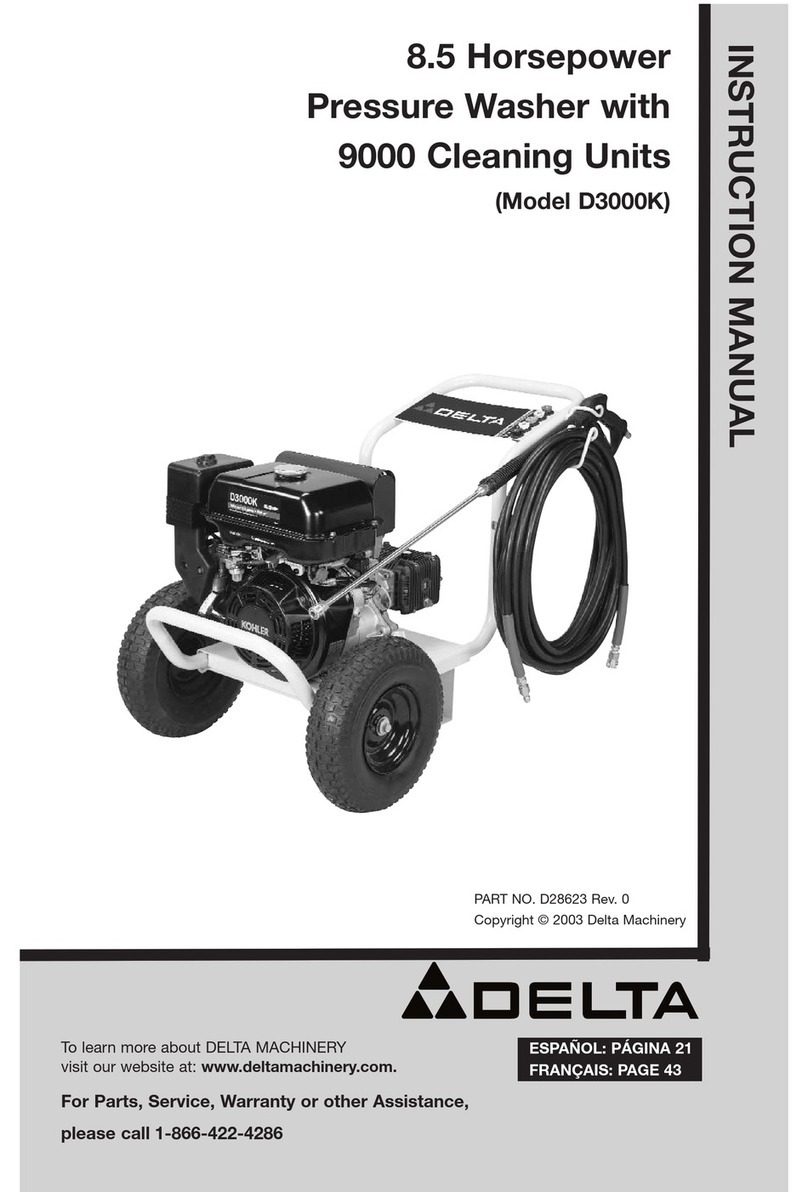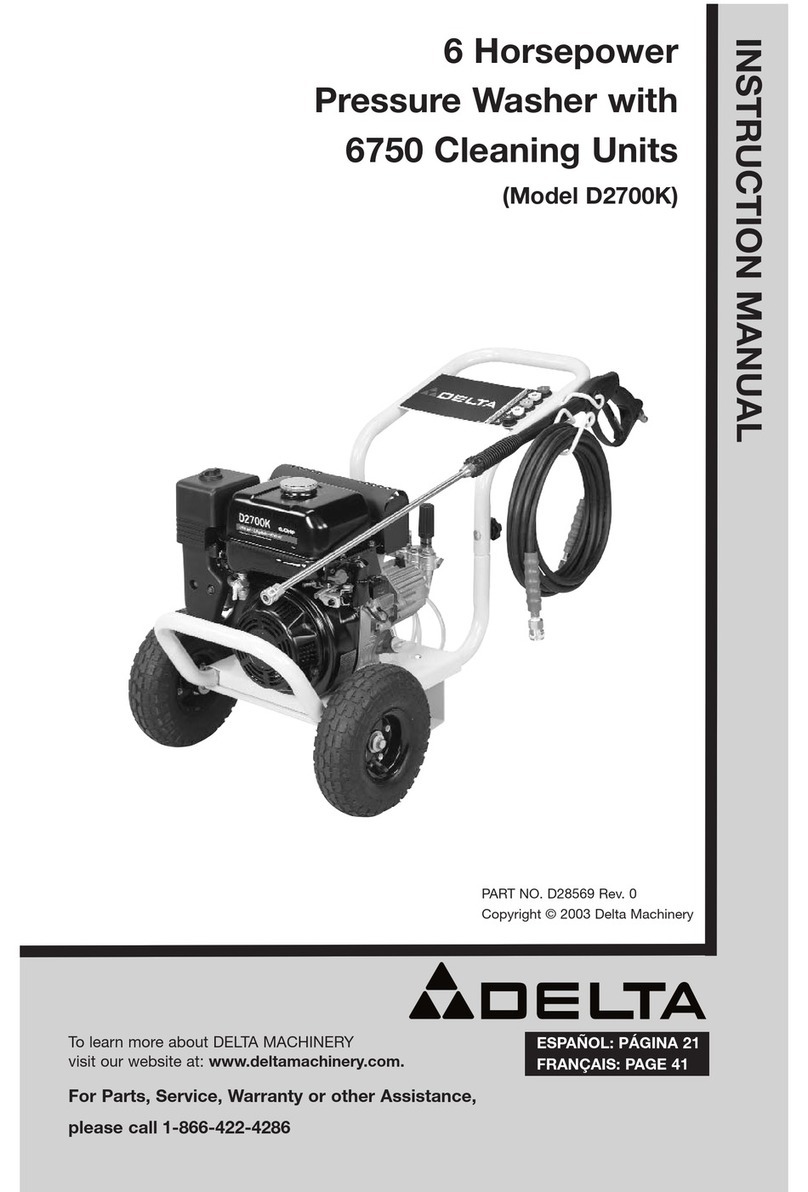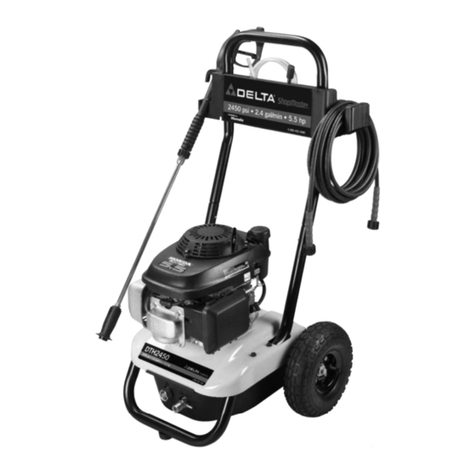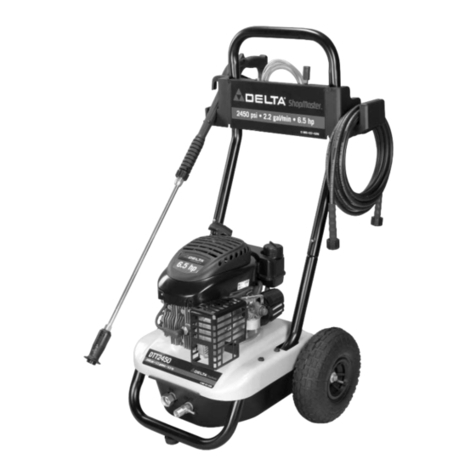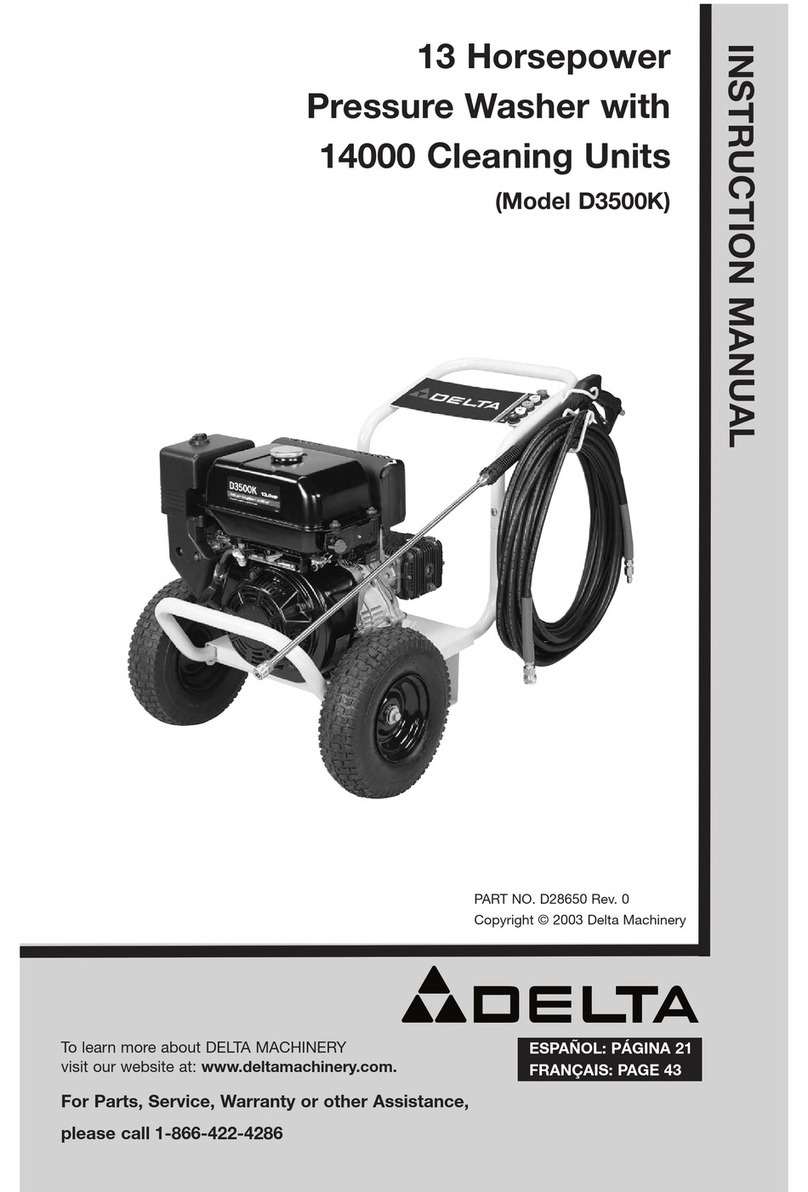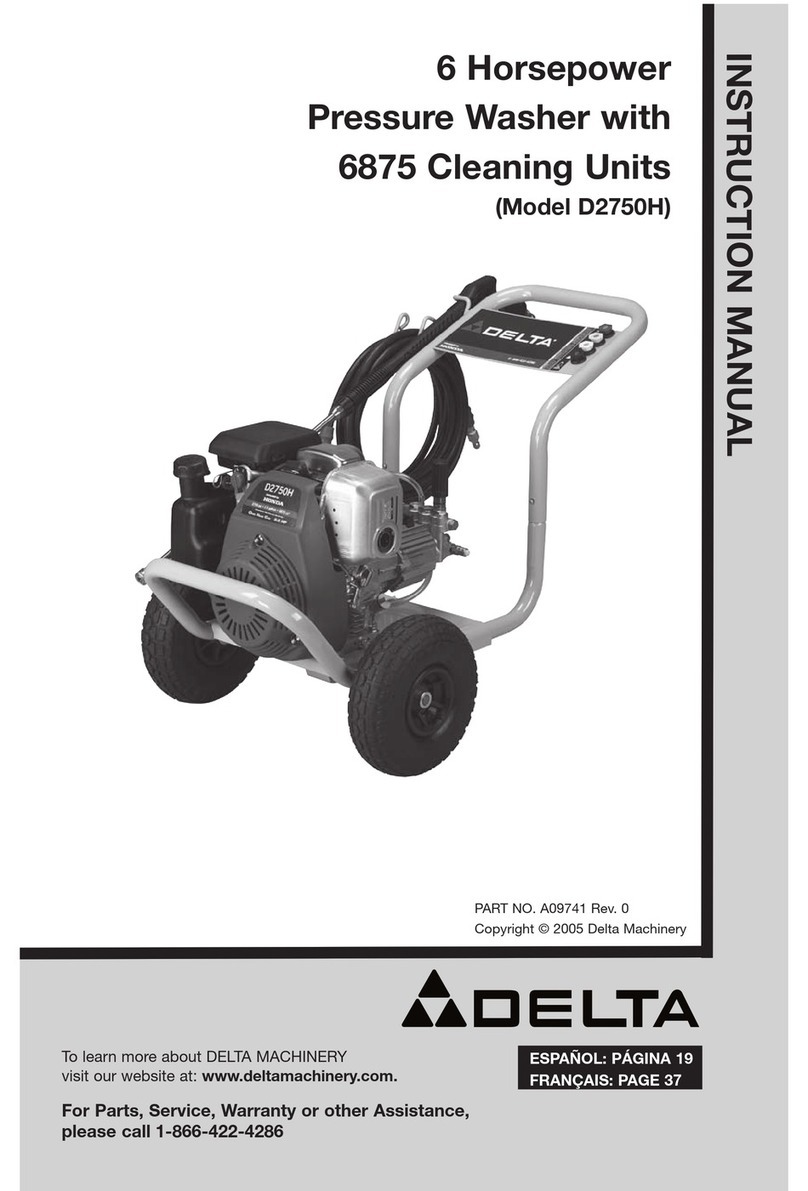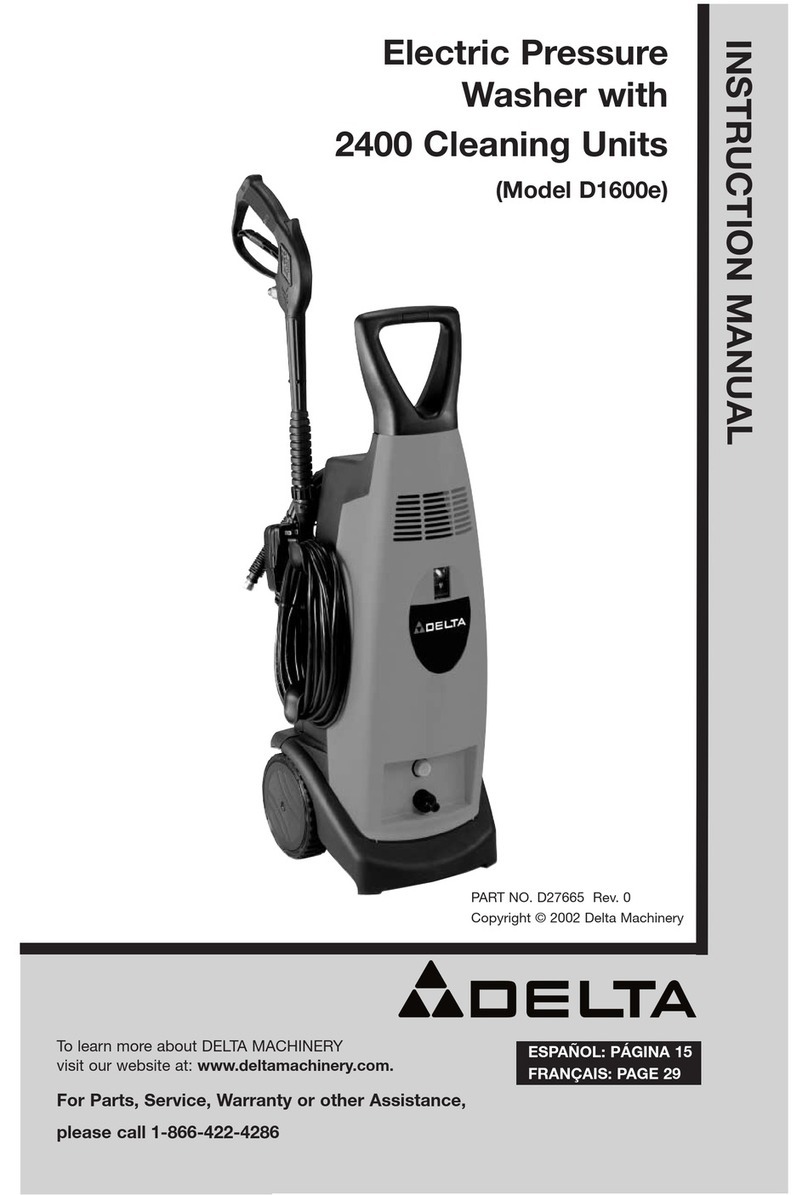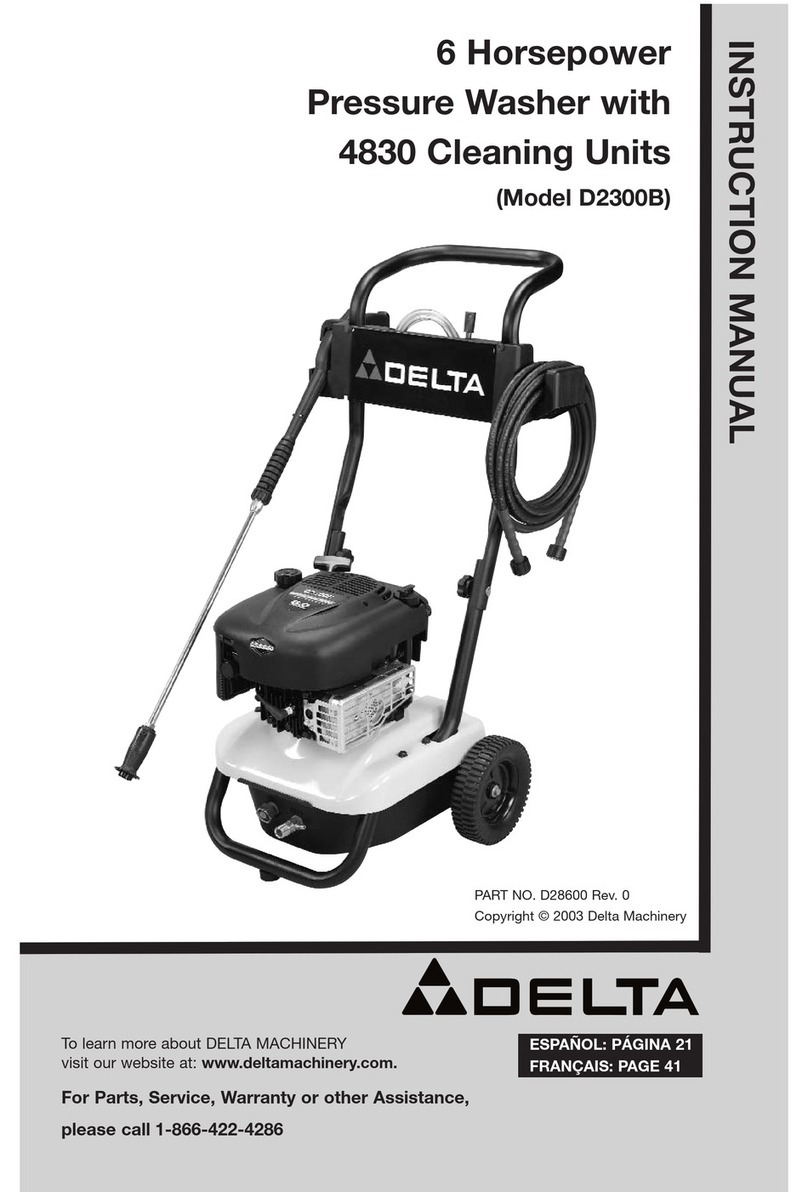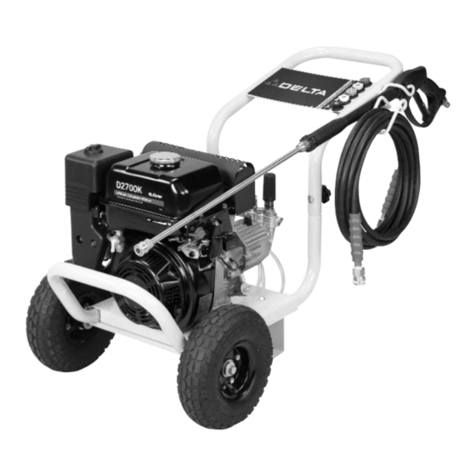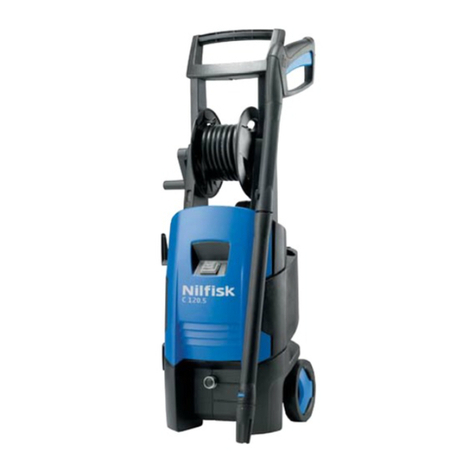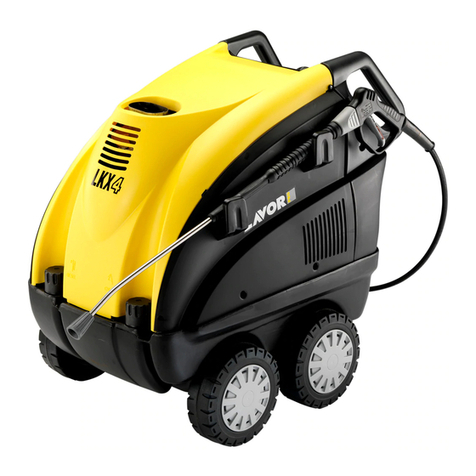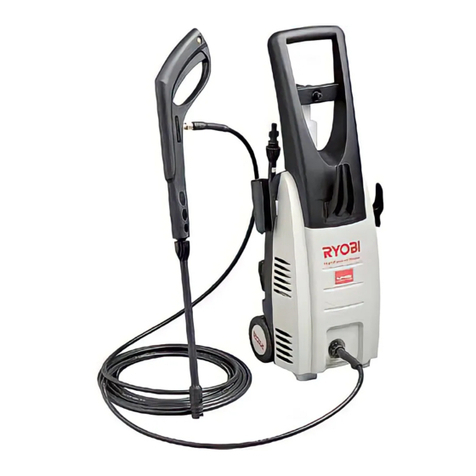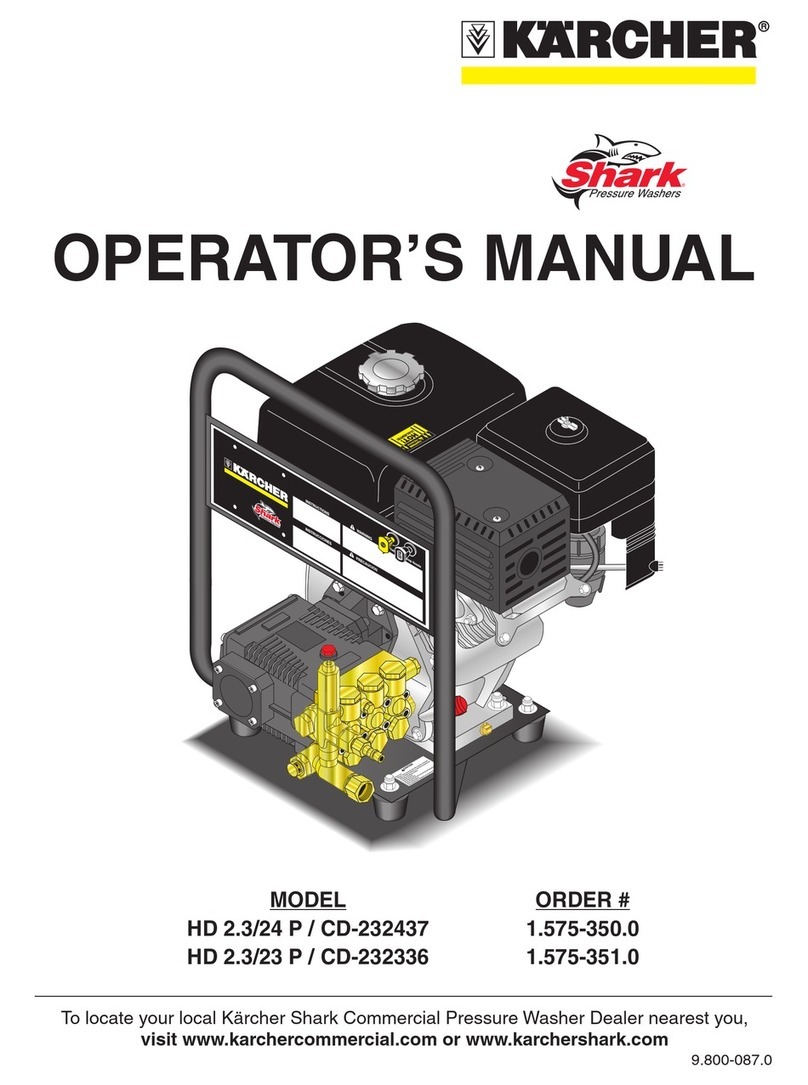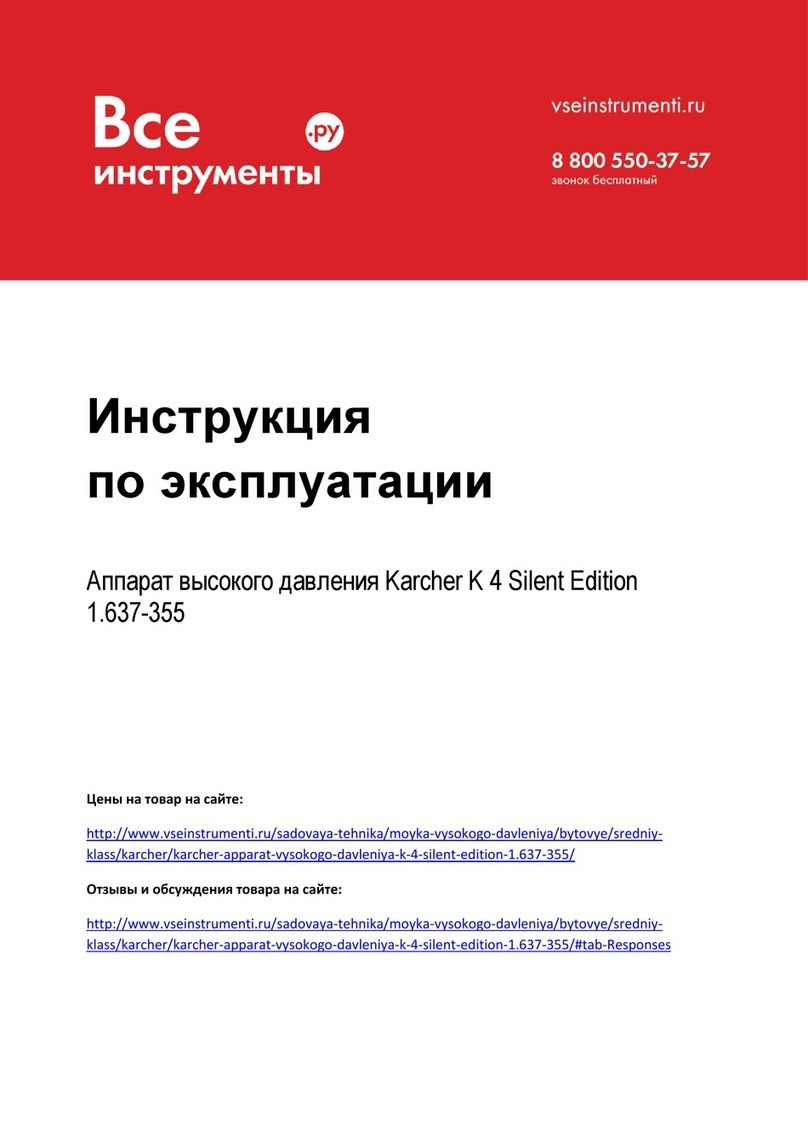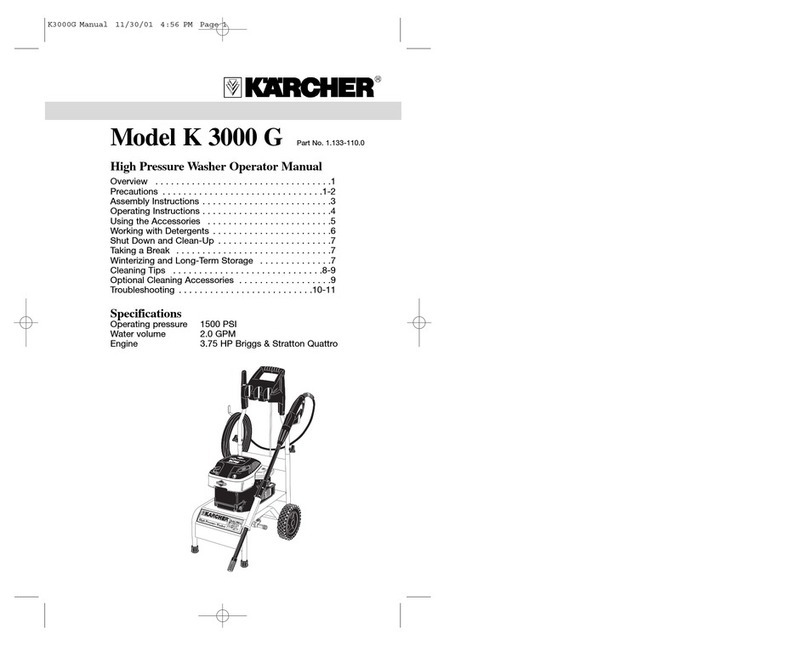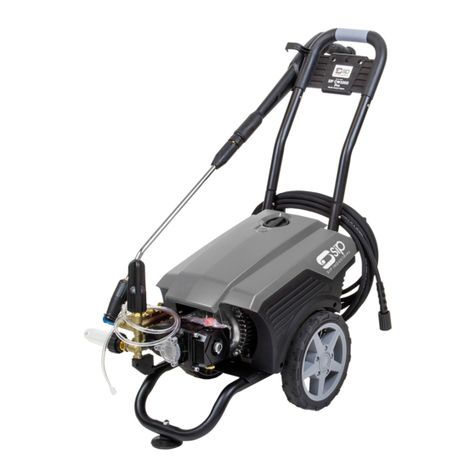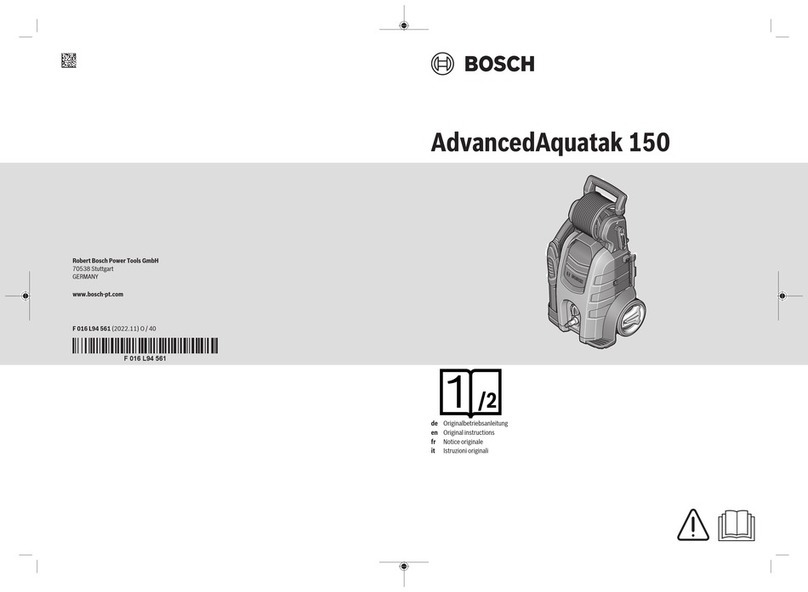Delta DT2200P User manual

INSTRUCTIONMANUAL
PART NO. D25130 Rev. 0
Copyright © 2001 Delta Machinery
ESPAÑOL: PÁGINA 23
FRANÇAIS: PAGE 45
To learn more about DELTA MACHINERY
visit our website at: www.deltamachinery.com.
For Parts, Service, Warranty or other Assistance,
please call 1-866-422-4286
4.5 Horsepower
Pressure Washer with
4400 Cleaning Units
(Model DT2200P)

2- ENG
D25130
This product may not be equipped with a spark arresting muffler. If
the product is not equipped and will be used around flammable
materials, or on land covered with materials such as agricultural crops, forest,
brush, grass, or other similar items, then an approved spark arrester must be
installed and is legally required in the state of California. It is a violation of
California statutes section 130050 and/or sections 4442 and 4443 of the
California Public Resources Code, unless the engine is equipped with a spark
arrester, as defined in section 4442, and maintained in effective working order.
Spark arrester are also required on some U.S. Forest Service land and may also
be legally required under other statutes and ordinances.
Engine exhaust contains chemicals known, in certain quantities, to cause cancer,
birth defects or other reproductive harm.
Read Operator’s Manual. Do not operate equipment until you have
read Operator’s Manual for Safety, Assembly, Operation, and
Maintenance Instructions.
GENERAL INFORMATION
●Congratulations! You have purchased a high quality product from
America’s leading manufacturer of pressure washers. This pressure wash-
er, when properly used and maintained, will provide trouble free service.
Please read and follow these instructions for proper use and maintenance.
●All sales of pressure washers are final. Do not return this product to the
retailer.
●If you experience any problems and need assistance, please call us at our
toll free number 1-866-422-4286, Monday through Saturday, 8:00 a.m.
To 6:00 p.m. C.S.T.
●If repair or service part purchase is required, our many Authorized
Warranty Service Centers are conveniently located and equipped to handle
all in-warranty and out-of-warranty service.
●For the location of the nearest Authorized Warranty Service Center call
1-866-422-4286, 24 hours a day, 7 days a week or visit our web site @
www.deltamachinery.com.
●All pressure washers carry a manufacturer's one year warranty from date
of purchase for consumer use and a 90 day warranty for commercial use.
●Retain sales receipt as proof of purchase for warranty service.
●Do not operate this unit until you have read and understand this Owners
Manual for Safety, Operation, and Maintenance Instructions.
●Do not operate this unit until you have read and understand the Engine
Owners Manual for Safety, Operation, and Maintenance Instructions.

3- ENG D25130
used without the
safety alert symbol
indicates a potentially hazardous situ-
ation which, if not avoided, may result
in property damage.
indicates a poten-
tially hazardous sit-
uation which, if not avoided, could
result in death or serious injury.
This manual contains information that is important for you to know and under-
stand. This information relates to protecting YOUR SAFETY and PREVENTING
EQUIPMENT PROBLEMS. To help you recognize this information, we use the
symbols below. Please read and understand the manual and pay attention to
these symbols.
10/2/97
SAFETY GUIDELINES - DEFINITIONS
indicates an immi-
nently hazardous
situation which, if not avoided, will
result in death or serious injury.
indicates a potential-
ly hazardous situa-
tion which, if not avoided, may result
in minor or moderate injury.
HAZARD
HOW TO PREVENT ITWHAT CAN HAPPEN
RISK OF EXPLOSION OR FIRE
• Spilled gasoline and it’s vapors can be-
come ignited from cigarette sparks,
electrical arcing, exhaust gases, and hot
engine components such as the muffler.
• Heat will expand fuel in the tank which
could result in spillage and possible fire
explosion.
• Operating the pressure washer in an ex-
plosive environment could result in a
fire.
• Materials placed against or near the
pressure washer can interfere with its
proper ventilation features causing over-
heating and possible ignition of the
materials.
• Muffler exhaust heat can damage paint-
ed surfaces, melt any material sensitive
to heat (such as siding, plastic, rubber,
or vinyl), and damage live plants.
• Shut off engine and allow it to cool
before adding fuel to the tank.
• Use care in filling tank to avoid spilling
fuel. Move pressure washer away from
fueling area before starting engine.
• Keep maximum fuel level ½” below top
of tank to allow for expansion.
• Always keep pressure washer a mini-
mum of four feet away from surfaces
(such as houses, automobiles, or live
plants) that could be damaged from
muffler exhaust heat.
• Operate and fuel equipment in well ven-
tilated areas free from obstructions.
Equip areas with fire extinguishers suit-
able for gasoline fires.
• Never operate pressure washer in an
area containing dry brush or weeds.
IMPORTANT SAFETY INSTRUCTIONS

4- ENG
D25130
RISK TO BREATHING
• Some cleaning fluids contain substances
which could cause injury to skin, eyes, or
lungs.
HAZARD
HOW TO PREVENT ITWHAT CAN HAPPEN
• Operate pressure washer in a well venti-
lated area. Avoid enclosed areas such
as garages, basements ,etc.
• Never operate unit in a location occu-
pied by humans or animals.
• Use only cleaning fluids specifically rec-
ommended for high pressure washers.
Follow manufacturers recommenda-
tions.Do not use chlorine bleach or any
other corrosive compound
• Breathing exhaust fumes will cause seri-
ous injury or death.
• Use of acids, toxic or corrosive chemi-
cals, poisons, insecticides, or any kind of
flammable solvent with this product
could result in serious injury or death.
• Improperly stored fuel could lead to ac-
cidental ignition. Fuel improperly
secured could get into the hands of chil-
dren or other unqualified persons.
• Do not spray flammable liquids
• Store fuel in an OSHA approved con-
tainer, in a secure location away from
work area.
HAZARD
RISK OF EXPLOSION OR FIRE
(continued)
HOW TO PREVENT ITWHAT CAN HAPPEN

5- ENG D25130
RISK OF UNSAFE OPERATION
•If proper starting procedure is not fol-
lowed, engine can kickback causing
serious hand and arm injury.
HAZARD
HOW TO PREVENT ITWHAT CAN HAPPEN
• Become familiar with the operation and
controls of the pressure washer.
• Keep operating area clear of all persons,
pets, and obstacles.
• Do not operate the product when
fatigued or under the influence of alco-
hol or drugs. Stay alert at all times.
• Never defeat the safety features of this
product.
• Do not operate machine with missing,
broken, or unauthorized parts.
• Never leave wand unattended while unit
is running.
•If engine does not start after two
pulls, squeeze trigger of gun to
relieve pump pressure. Pull starter
cord slowly until resistance is felt.
Then pull cord rapidly to avoid kick-
back and prevent hand or arm injury.
• Unsafe operation of your pressure
washer could lead to serious injury or
death to you or others.
• The spray gun/wand is a powerful clean-
ing tool that could look like a toy to a
child.
• Keep children away from the pressure
washer at all times.
• Reactive force of spray will cause
gun/wand to move, and could cause the
operator to slip or fall, or misdirect the
spray. Improper control of gun/wand can
result in injuries to self and others.
• Do not overreach or stand on an unsta-
ble support. Grip gun/wand firmly with
both hands. Expect the gun to kick
when triggered.
RISK OF ELECTRICAL SHOCK
• Spray directed at electrical outlets or
switches, or objects connected to an
electrical circuit, could result in a fatal
electrical shock.
• Unplug any electrically operated product
before attempting to clean it. Direct
spray away from electric outlets and
switches.
HAZARD
HOW TO PREVENT ITWHAT CAN HAPPEN

6- ENG
D25130
HOW TO PREVENT ITWHAT CAN HAPPEN
HAZARD
RISK OF CHEMICAL BURN
• Use of acids, toxic or corrosive chemi-
cals, poisons, insecticides, or any kind
of flammable solvent with this product
could result in serious injury or death.
• Do not use acids, gasoline, kerosene, or
any other flammable materials in this
product. Use only household deter-
gents, cleaners and degreasers recom-
mended for use in pressure washers.
• Wear protective clothing to protect eyes
and skin from contact with sprayed
materials.
• Do not use chlorine bleach or any other
corrosive compound.
HOW TO PREVENT ITWHAT CAN HAPPEN
RISK TO FLUID INJECTION
• Your washer operates at fluid pressures
and velocities high enough to penetrate
human and animal flesh, which could
result in amputation or other serious
injury. Leaks caused by loose fittings or
worn or damaged hoses can result in
injection injuries. DO NOT TREAT FLUID
INJECTION AS A SIMPLE CUT! See a
physician immediately!
• Never place hands in front of nozzle.
• Direct spray away from self and others.
• Make sure hose and fittings are tight-
ened and in good condition. Never
hold onto the hose or fittings during op-
eration.
• Do not allow hose to contact muffler.
• Never attach or remove wand or hose
fittings while system is pressurized.
• Use only hose and high pressure
accessories rated for pressure higher
than your pressure washer's p.s.i.
HAZARD
• Relieve system pressure before at-
tempting maintenance or disassembly
of equipment.
• To relieve system pressure, shut off
engine, turn off water supply, and pull
gun trigger until water stops flowing.

7- ENG D25130
HOW TO PREVENT ITWHAT CAN HAPPEN
HAZARD
RISK OF HOT SURFACES
• Contact with hot surfaces, such as
engines exhaust components, could
result in serious burn.
• During operation, touch only the control
surfaces of the pressure washer. Keep
children away from the pressure washer
at all times. They may not be able to
recognize the hazards of this product.
HOW TO PREVENT ITWHAT CAN HAPPEN
HAZARD
• Fuel or oil can leak or spill and could
result in fire or breathing hazard, serious
injury or death can result. Fuel or oil
leaks will damage carpet, paint or other
surfaces in vehicles or trailers.
• If pressure washer is equipped with a
fuel shut-off valve, turn the valve to the
off position before transporting to avoid
fuel leaks. If pressure washer is not
equipped with a fuel shut-off valve, drain
the fuel from tank before transporting.
Only transport fuel in an OSHA
approved container. Always place pres-
sure washer on a protective mat when
transporting to protect against damage
to vehicle from leaks. Remove pressure
washer from vehicle immediately upon
arrival at your destination.
RISK OF INJURY AND PROPERTY
DAMAGE WHEN TRANSPORTING
OR STORING
The powerful spray from your pressure washer is capable of caus-
ing damage to surfaces such as wood, glass, automobile paint, auto
striping and trim, and delicate objects such as flowers and shrubs. Before spraying,
check the item to be cleaned to assure yourself that it is strong enough to resist
damage from the force of the spray. Avoid the use of the concentrated spray stream
except for very strong surfaces like concrete and steel.
Operating without flow of water will result in equipment damage. Operating the pres-
sure washer with water supply shutoff will void your warranty. You should never run
this pressure washer for more than 2 minutes without pulling the trigger to allow cool
water to enter the pump and the heated (recirculated) water to exit.

8- ENG
D25130
2. Connect wand to gun. Tighten
securely.
3. Attach high pressure hose to gun.
Tighten securely.
ASSEMBLY
1. Place handle assembly onto
frame and connect handle to
frame.
BOX CONTENTS
Handle Bagged Parts
Nozzle Cleaning
Kit
English/
Spanish/
French
Operator’s
Manual
Engine Frame and
Wheel Assembly
High Pressure
Hose Chemical Hose
Engine Oil
Spray Gun Multi-Reg Wand
Bagged Accessories Panel
Knobs
Saddle
Bolts
Engine
Manual
Accessories Panel

9- ENG D25130
5. To Assemble Accessories Panel
a. Remove top screws on han-
dle assembly.
b. Loosen bottom screws on
handle assembly.
c. Place grooves in accessories
panel assembly onto screws
and slide panel assembly
into place.
d. Place screws (removed earli-
er) into the top holes and
secure accessories panel
assembly to handles. Do
not overtighten.
6. Add engine oil (supplied) to
engine. Refer to engine manual
supplied by engine manufacturer
for correct procedure.
NOTE: There will be a slight amount
of oil in the engine from factory test-
ing.
NOTE: The high pressure pump was
filled with oil at the factory. There is
no need to add oil at this time, see
the Maintenance section of this man-
ual for Maintenance information.
Loosen
Screws
Remove

10- ENG
D25130
PRESSURE WASHER
High Pressure Pump: Increases the
pressure of the water supply.
Engine: Drives the high pressure
pump.
High Pressure Hose: Carries the
pressurized water from the pump to
the gun and wand.
Spray Gun: Connects with wand to
control water flow rate, direction, and
pressure.
Multi-Reg Wand: Has a spray nozzle
which adjust from a pencil stream (0°)
to a wide angle fan spray (40°). The
spray can be adjusted by twisting the
nozzle clockwise and/or counter-
clockwise. Also, the high and low
pressure settings can be controlled
by moving the nozzle in and out. See
Operation section.
ENGINE
Refer to the engine manual for loca-
tion and operation of engine controls.
Chemical Hose: Allows cleaners or
cleaning solvents to be mixed with
the pressurized water stream. See
How To Siphon Chemicals/Cleaning
Solvents in Operation section of this
manual.
OPERATION
Know Your Pressure Washer
READ THIS OWNER’S MANUAL AND SAFETY RULES BEFORE OPERATING
YOUR UNIT. Compare the illustrations with your unit to familiarize yourself with
the location of various controls and adjustments. Save this manual for future
reference.
High
Pressure
Pump
Engine
High
Pressure
Hose
Spray
Gun
Multi-Reg
Wand
Chemical
Hose
PRESSURE WASHER
TERMINOLOGY
NOTE: Become familiar with this ter-
minology before operating.
PSI: Pounds per Square Inch. The
unit of measure for water pressure.
Also used for air pressure, hydraulic
pressure, etc.

11- ENG D25130
GPM: Gallons Per Minute. The unit
of measure for the flow rate of water
through the pressure washer.
CU: Cleaning Units. GPM multiplied
by PSI.
Bypass Mode: In Bypass Mode, the
pump is recirculating water because
the trigger of the spray gun is not
pulled. If unit is left in bypass mode
for more than two (2) minutes, the
water temperature will rise to a dan-
gerous level and can damage internal
components of the pump. Any dam-
age to pump due to these causes will
not be covered under warranty.
DO NOT allow your
unit to operate in
bypass mode for more than two
minutes at any time. Overheating
of pump will cause damage to
pump.
Thermal Relief Valve:
In an effort to prevent
damage, pumps are
equipped with a ther-
mal relief valve. This
valve will open when
the temperature inside the pump
rises too high. This valve will then
release a gush of water in an effort to
lower the temperature inside the
pump. Immediately after this occurs,
the valve will close.
Chemical Injection: Feeds cleaning
agents into the pump to mix with the
pressurized water and help in clean-
ing.
Water Supply: All pressure washers
must have a source of water. The
minimum requirements for a water
supply are 20 PSI and 5 gallons per
minute.
HOW TO USE
IMPORTANT: Read and understand
how to use the pressure washer
before operating.
TO USE WAND
Your pressure washer is equipped
with a multi-reg wand with both high
and low pressure settings. The high
pressure setting is for cleaning and
rinsing, the low pressure setting is for
applying chemicals or cleaning solu-
tions to surfaces.
Risk of injection or
injury to person. Do
not direct discharge stream toward
persons, unprotected skin, eyes, or
any pets or animals. Serious injury
can occur.
For high pressure operation, pull back
the nozzle of the multi-reg wand as
shown.
Thermal
Relief
Valve
TO ADJUST PRESSURE
The pressure setting is preset at the
factory to achieve optimum pressure
and cleaning. If you need to lower the
pressure, it can be accomplished by
these methods.
1. Back away from the surface to be
cleaned. The further away you
are, the less the pressure will be
on the surface to be cleaned.
2. Reduce the speed of the gaso-
line engine (RPM). Slow the
engine down and the water pres-
sure will go down with it.
DO NOT attempt to
increase pump
pressure. A higher pressure set-
ting than the factory set pressure
may damage pump.

12- ENG
D25130
The nozzle at the end of the multi-reg
wand can be rotated to change the
high pressure spray pattern from a
narrow jet to a 40º fan shape, as
shown. Markings have been placed
on the nozzle to help you select the
spray pattern.
For low pressure operation, extend
the nozzle of the multi-reg wand as
shown.
40º fan spray
narrow jet stream
TO SIPHON
CHEMICALS/CLEANING
SOLVENTS
Siphoning chemicals or cleaning sol-
vents is a low pressure operation.
NOTE: Use only soaps and chemi-
cals designed for pressure washer
use. Do not use bleach.
1. Press chemical hose onto
barbed fitting located near high
pressure hose connection of
pump as shown.
2. Place other end of chemical hose
with filter on it into container
holding chemical/cleaning solu-
tion.
3. Set multi-reg nozzle to low pres-
sure setting, see How To Use
Wand paragraph in this section.
4. After use of chemical, siphon
clean water through chemical
hose to rinse it and pump clean.
Chemicals which remain in pump
can damage it. Damage to pump
due to chemicals will not be cov-
ered under warranty.
NOTE: Chemicals and soap will not
siphon when wand is in the high
pressure setting.
Barb fitting
TO SHUT DOWN
IMPORTANT: Read and understand
how to shut down the pressure
washer before operating.
1. If you have siphoned chemicals,
siphon a bucket of clean water
through the chemical hose.
NOTE: Failure to do so will
cause damage to the pump.
2. Refer to engine manual for cor-
rect engine shut down proce-
dure.
NOTE: NEVER turn the water off
with the engine running.
3. Turn water source off.
4. Pull trigger on spray gun to
relieve any water pressure in
hose or spray gun.
5. See Storage section in this man-
ual for proper storage proce-
dures.

13- ENG D25130
4. Connect high pressure hose to
pump outlet.
5. Connect water source to pump
inlet.
NOTE: Water source must provide
a minimum of 5 gallons per minute
at 20 p.s.i.
6. If you are applying a chemical or
cleaning solution, See How To
Siphon Chemicals/Cleaning
Solvents in Operation section of
this manual.
7. Turn water source on.
NOTE: Make sure water supply is
turned on.
8. Start engine, refer to engine
manual for correct procedure.
If the engine does
not start after two
pulls, pull the trigger to relieve the
pressure.
9. Depress trigger on gun to start
water flow. Release trigger to
stop water flow.
10. Adjust nozzle spray for the task
being performed. See How To
Use Wand instructions in this
section.
DO NOT let hoses
come in contact
with very hot engine muffler during
or immediately after use of your
pressure washer.
Water
Source
High
Pressure
Hose
Filter Screen
BEFORE STARTING
Read and understand all Important
Safety Instructions in the front of
this manual and the following
Cautions and Warnings before
starting the pressure washer.
• Never fill fuel tank completely.
Fill tank to 1/2" below bottom
of filler neck to provide space
for fuel expansion. Wipe any
fuel spillage from engine and
equipment before starting
engine.
• Never fill fuel tank indoors.
Never fill fuel tank when engine
is running or hot. Do not
smoke when filling fuel tank.
• Never run engine indoors or in
enclosed, poorly ventilated
areas. Engine exhaust con-
tains carbon monoxide, an
odorless and deadly gas.
• Never turn water supply off
while pressure washer engine
is running or damage to pump
will result.
• DO NOT use hot water, use
cold water only.
• DO NOT stop spraying water
for more than two minutes at a
time.
1. Add fresh high quality unleaded
gasoline with a pump octane rat-
ing of 86 or higher. Do not over-
fill. Wipe up spilled fuel before
starting the engine. Refer to
engine manual for correct proce-
dure.
2. Check engine oil. Refer to the
engine manual for correct proce-
dure.
NOTE: There will be a slight
amount of oil in the engine form
factory tiesting.
3. Verify the filter screen is in water
inlet of pump, as shown.

14- ENG
D25130
MAINTENANCE
WHEN PERFORMING MAINTENANCE, YOU MAY BE
EXPOSED TO HOT SURFACES, WATER PRESSURE, MOV-
ING PARTS, OR FIRE RESULTING IN DEATH. BEFORE PERFORMING ANY
MAINTENANCE OR REPAIR, DISCONNECT SPARK PLUG WIRE, LET
ENGINE COOL AND RELEASE ALL WATER PRESSURE. THE ENGINE CON-
TAINS FLAMMABLE FUEL. DO NOT SMOKE OR WORK NEAR OPEN
FLAMES WHILE PERFORMING MAINTENANCE.
To ensure efficient operation and longer life of your pressure washer, a routine
maintenance schedule should be prepared and followed. If the pressure washer
is used in unusual conditions, such as high-temperatures or dusty conditions,
more frequent maintenance checks will be required.
CUSTOMER RESPONSIBILITIES TABLE
MAINTENANCE TASK
PRESSURE WASHER
check/clean inlet screen
check high pressure hose
check soap and chemical
hose and filter
check gun and wand for leaks
prepare for storage
Before
each use
Every 25
hours or
yearly
Every 50
hours or
yearly
Every 100
hours or
yearly
Prepare unit for storage if it is to remain idle for longer
than 30 days
X
X
X
X
ENGINE
Refer to engine manual for the manufacturer’s recommendations for any
and all maintenance.
HIGH PRESSURE PUMP
* The oil in the high pressure pump was designed to last the life of the
pump. If there is a problem with the pump contact an Authorized Service
Center.
check/change oil*

15- ENG D25130
5. Remove the nozzle from the end
of the wand with the 2mm allen
wrench provided as shown.
6. Clean the nozzle using the nozzle
cleaner provided or a straight-
ened paper clip. Insert into the
nozzle end and work back and
forth until obstruction is re-
moved.
7. Direct water supply into nozzle
end to backflush loosened parti-
cles for 30 seconds.
8. Reconnect spark plug wire.
9. Reassemble the nozzle to the
wand. Tighten securely to pre-
vent leaks.
10. Reconnect wand to gun and turn
on water supply.
11. Start pressure washer and place
wand into high pressure setting
to test.
WAND
If the nozzle becomes clogged with
foreign materials, such as dirt, exces-
sive pressure may develop. If the
nozzle becomes partially clogged or
restricted, the pump pressure will pul-
sate. Clean the nozzle immediately
using the nozzle kit supplied and the
following instructions:
1. Shut off the pressure washer and
turn off the water supply.
2. Disconnect spark plug wire.
3. Pull trigger on gun handle to
relieve any water pressure.
4. Disconnect the wand from the
gun.
PUMP
This screen filter should be checked
periodically and cleaned if necessary.
1. Remove filter by grasping end
and removing it from water inlet
of pump as shown.
2. Clean filter by flushing it with
water on both sides.
3. Install filter into water inlet of
pump
Filter Screen

16- ENG
D25130
ENGINE
Refer to the engine manual for the
manufacturer’s recommendations for
storage.
PUMP
It is recommended that you follow
these steps to protect the internal
seals of the pressure washer when
storing the unit for an extended
period and WHEN FREEZING TEM-
PERATURES ARE EXPECTED.
NOTE: If storing the unit for more
than 30 days RV antifreeze or wind-
shield washer fluid needs to be run
through the pump. This helps pre-
vent damage within the pump head.
RV antifreeze or windshield washer
fluid is not only added for winteriz-
ing, but for proper lubrication
regardless of temperature or envi-
ronment. Storing the pump less than
30 days does not require the RV
antifreeze or windshield washer
fluid.
1. Obtain a funnel, six ounces of RV
antifreeze or windshield washer
fluid, and approximately 12 inches
of garden hose with a male hose
connector attached to one end.
Use only RV
antifreeze. Any
other antifreeze is corrosive and can
damage pump.
2. Disconnect spark plug wire.
3. Disconnect high pressure hose
from pump and from spray gun.
4. Connect 12 inch length of hose to
water inlet of pump.
5. Add RV antifreeze or windshield
washer fluid to hose as shown.
6. Pull engine starter rope slowly
several times until antifreeze or
windshield washer fluid comes
out of high pressure hose connec-
tion of pump.
7. Remove short hose from water
inlet of pump.
8. Reconnect spark plug wire.
9. Drain all water from high pressure
hose, coil it, and store it in cradle
of the pressure washer handle.
10. Drain all water from spray gun and
wand by holding spray gun in a
vertical position with nozzle end
pointing down and squeezing trig-
ger. Store in gun/hose holder.
11. Store chemical hose, high pres-
sure hose, spray gun, and wand
so they are protected from dam-
age, such as being run over.
STORAGE

17- ENG D25130
TROUBLESHOOTING GUIDE
PROBLEM CAUSE CORRECTION
Engine will not
start (see
Engine Manual
for further
engine trouble-
shooting)
1. No fuel.
2. Pressure builds up after
two pulls on the recoil
starter or after initial use.
3. Not choked.
4. Spark plug wire not
attached.
5. Choke lever in the
"Choke" position on a
"hot" engine or an engine
that has been exposed to
thermal heat for a long
period of time.
6. Fuel valve closed
1. Add Fuel.
2. Squeeze gun trigger to
relieve pressure.
3. Choke engine, place
engine in the choke posi-
tion.
4. Attach spark plug wire.
5. Move choke to the "No
Choke" position.
6. Move the fuel valve knob
to the "Open" position.
No or low
pressure
(initial use)
1. Wand not in high pres-
sure.
1. See How to Use Wand
paragraph in the
Operation Section.
2. Low water supply. 2. Water supply must be at
least 5 GPM @ 20 PSI.
3. Leak at high pressure
hose.
3. Repair leak. Apply sealant
tape if necessary.
4. Nozzle obstructed. 4. Clean nozzle with paper
clip or nozzle cleaning
tool, pour water into noz-
zle end to flush out ob-
struction.
5. Water filter screen
clogged.
5. Remove and clean filter.

18- ENG
D25130
6. Air in hose. 6. Turn off the engine, then
the water source.
Disconnect the water
source from the pump
inlet and turn the water
source on to remove all air
from the hose. When there
is a steady stream of
water present, turn water
source off. Reconnect
water source to pump inlet
and turn on water source.
Squeeze trigger to remove
remaining air.
7. Choke lever in the
"Choke" position.
8. Throttle control lever is
not in the "Fast" position.
9. High pressure hose is too
long.
7. Move choke to the "No
Choke" position.
8. Move throttle control lever
to the "Fast" position.
9. Use high pressure hose
under 100 feet.
PROBLEM CAUSE CORRECTION
No or low
pressure
(initial use)
(continued)
6. Chemical build up in
chemical injector.
Will not draw
chemicals
1. Wand not in low
pressure.
2. Chemical filter clogged.
3. Chemical screen not in
chemical
4. Chemical too thick
5. Pressure hose is too long
2. Clean filter.
3. Insure end of chemical
hose is fully submerged
into chemical.
4. Dilute chemical. Chemical
should be the same con-
sistency as water.
5. Lengthen water supply
hose instead of pressure
hose.
6. Have parts cleaned or
replaced by AWSC.
1. See How to Use Wand
paragraph in the
Operation Section.

19- ENG D25130
PROBLEM CAUSE CORRECTION
No or low
pressure (after
period of nor-
mal use.)
Water leaking
at gun/wand
connection
Water leaking
at pump
1. Worn seal or packing.
2. Worn or obstructed
valves.
3. Worn unloader piston.
1. Worn or broken o-ring.
2. Loose hose connection.
1. Loose connections.
2. Piston packings worn.
3. Worn or broken o-rings.
4. Pump head or tubes dam-
aged from freezing.
1. Have replaced by AWSC.
2. Have replaced by AWSC.
3. Have replaced by AWSC.
1. Check and replace.
2. Tighten.
1. Tighten.
2. Have replaced by AWSC.
3. Have replaced by AWSC.
4. Have replaced by AWSC.
Oil leaking at
pump
1. Oil seals worn. 2. Have replaced by AWSC

20- ENG
D25130
4
REPAIR PARTS
Key# Part # Description
1 # Engine
2 * Pump Kit
3 D22166 High Pressure Hose
4 H140 Chemical Hose
5 17780 Spray Gun
6 D22837 Multi-Reg Wand
7 NCT001 Cleaning Tool
8 16797 Allen Wrench
9 D25073 Accessories Panel
10 D22901 Screws
11 D22275 Tire
12 W137 Pal Nut
13 D22316 Handle Assembly (includes Key#10)
# See engine manual for service information
* Contact an Authorized Service Center
1
2
3
5
6
7
8
9
10
11
12
13
Table of contents
Other Delta Pressure Washer manuals
Popular Pressure Washer manuals by other brands

Dirty Hand Tools
Dirty Hand Tools 101088 Operation manual

Champion Power Equipment
Champion Power Equipment 100386-EU Operator's manual

Maruyama
Maruyama MSW1012 Owner's/operator's manual
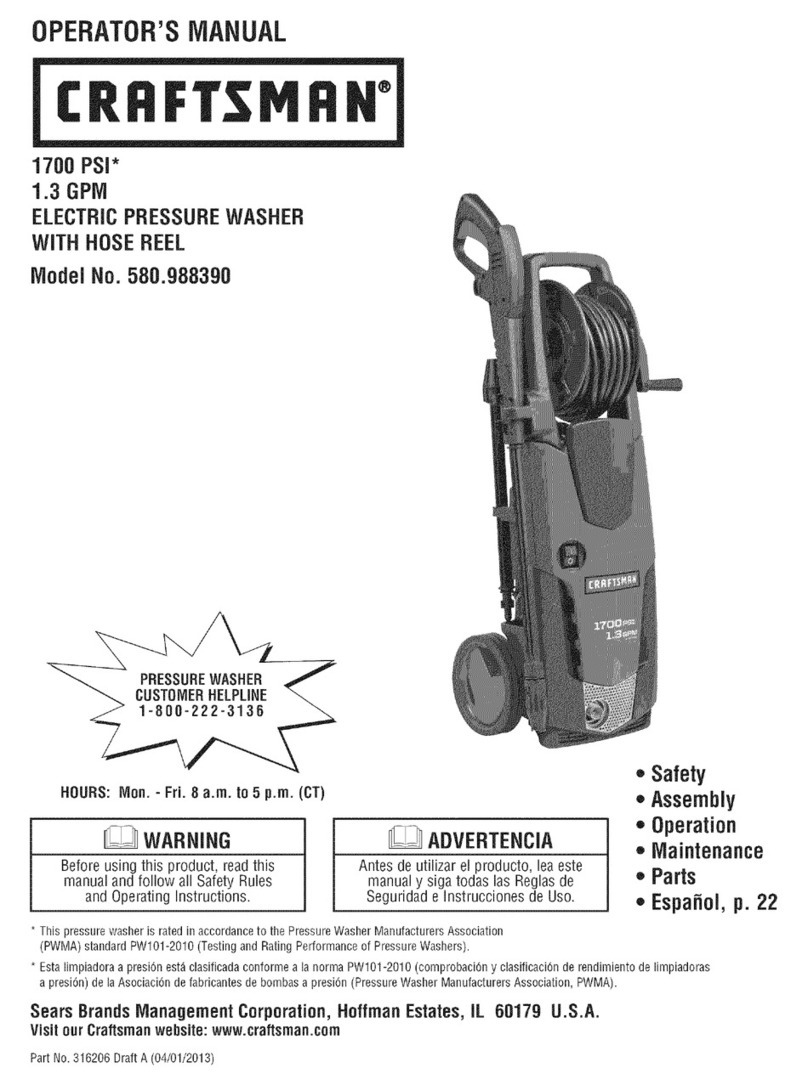
Craftsman
Craftsman 580.988390 Operator's manual
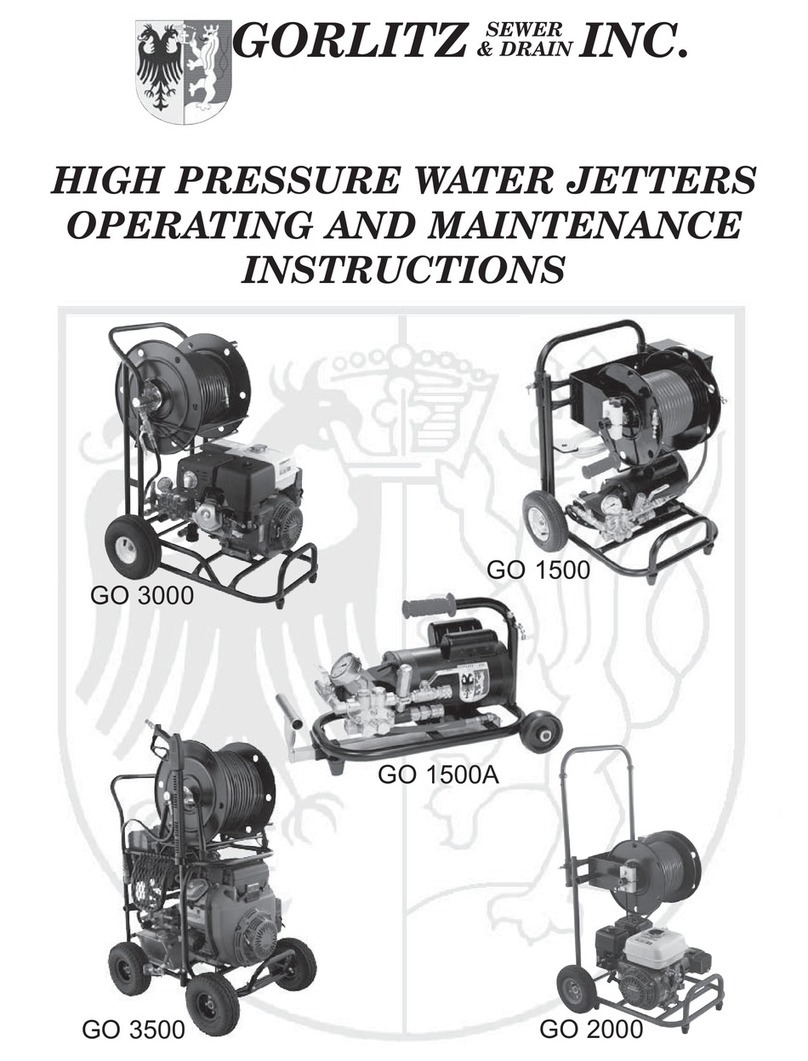
Gorlitz
Gorlitz GO 3000 Operating and maintenance instructions

GreenWorks
GreenWorks GPW2100 Operator's manual
